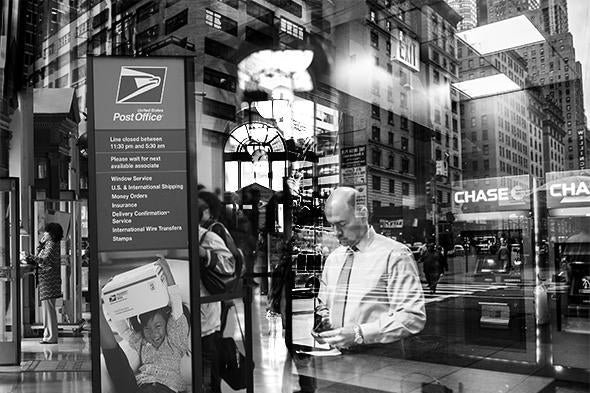The United States Postal Service has a problem. People aren’t sending as much mail as they used to. That means less postage revenue and difficulty paying the bills. Right now, the USPS has three main ideas about how to fix that. One is to increase stamp fees. Another is to reduce expenses by closing post offices and ending Saturday mail delivery. The third is competing head-to-head with Federal Express and UPS in parcel delivery. These are perfectly reasonable ideas, but they’re also limited ones. To keep USPS viable and vital, it’d be helpful to add a fourth idea from outside most Americans’ conception of what postal delivery is all about: basic banking and payment services.
Postal banking turns out to be fairly widespread in foreign countries, including Israel, South Korea, Ireland, and Germany. We even had a postal bank here in the U.S. for several decades, the Postal Savings System, inaugurated in 1911 and closed in the mid 1960s when high inflation made the system’s statutorily capped interest rates too low to be viable.
Current regulations embedded in the Postal Accountability and Enhancement Act of 2006 ban the USPS from entering new businesses. But Sen. Elizabeth Warren of Massachusetts has expressed interest in reviving postal banking. And even more strikingly, a recent white paper by the USPS inspector general says postal banking isn’t just desirable, but also legal under existing law, PAEA notwithstanding.
But the fundamental case for postal banking isn’t a matter of postal policy. It’s a matter of banking policy.
Start with the fact that about 10 percent of U.S. households don’t even have a checking account. These so-called “unbanked” Americans are simply cut off from the mainstream financial system. Lacking access to the regular payment system, the unbanked are forced to rely on high-fee storefront check-cashing operations or, increasingly, on prepaid debit cards, which can be an even worse financial deal. Meanwhile, paper money’s slow transformation into a distinctly non-mainstream mode of transaction is an irreversible trend.
Under the circumstances, there’s a strong case for creating a form of “public option” for basic banking—an institution that would hold deposits and provide payment services as a public mission, not a for-profit one. Turning the Postal Service into that public option makes sense for two reasons.
One is that the USPS already has the nationwide network of physical locations that an effective public bank would need. For USPS in its current form, though, this broad network of physical outlets has become a liability. Many post offices in rural areas in particular cost more money to run than they’re worth. The Postal Service would like to shut some of them down, saving money and costing local people convenience without risking much in the way of lost business. But Congress, in its never-ending determination to shower rural America with subsidies, has acted to prevent these sensible closures. If the USPS can’t shut down its physical facilities, we might as well take advantage of them by letting them offer a wider range of services.
The other persuasive reason for relying on the Postal Service rather than a brand-new public bank is simply that it might be easier. The Postal Savings System has been shuttered for decades, but remnants of it live on in the form of offerings such as money orders and a partnership with American Express to sell prepaid debit cards. Securing the blessing of the USPS Board of Governors for a more aggressive move into financial services would be a lot easier than ginning up a new act of Congress. The current postmaster general seems uninterested in the idea, but currently five out of the nine seats on the board are vacant, so timely executive appointments could change things quickly.
The inspector general’s report contemplates three kinds of financial products. On the most basic level, the Postal Service could offer a debit card associated with what amounts to a low-fee, no-interest checking account. You could deposit checks at a post office or via a smartphone app, buy stuff with your card, and set up direct deposit and electronic bill payment systems. One could go further by also adding interest-paying savings accounts or offering small-dollar loans.
That last step—of getting into full-fledged, loan-making banking—strikes me as unnecessary and risky. The odds of ending up with either an overly aggressive lender that eventually needs a bailout (like Fannie Mae) or a government-sponsored predatory lender (like state lotteries) are much too high. But the basic version of postal banking is a great idea. Postal banking cards and accounts could leverage the Postal Service’s existing infrastructure to earn a modest profit and undercut some of the sleaziest players in financial services. Once this kind of public option for basic financial services is up and running, adding a modest savings account scheme would be worth considering. Mainstream banks could continue their focus on offering higher-value services to more affluent clients, and low-income people would come into the financial mainstream.
Meanwhile, tens of thousands of postal jobs and hundreds of post offices would gain a new lease on life. The idea of combining financial services with postal ones sounds a bit odd. But the mash-up works well abroad. The time is right to try it here at home.
